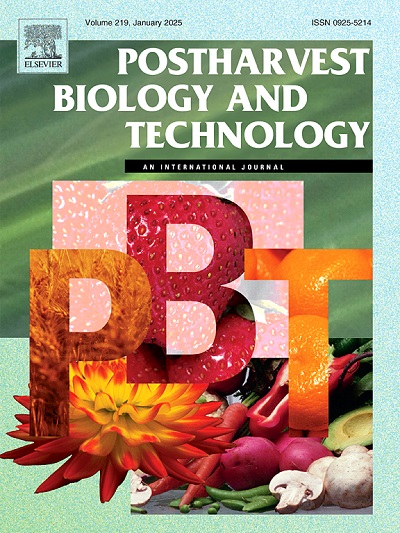在冷藏和模拟市场条件下,包装对有机洋蓟和常规洋蓟生理特性、化学成分和生物活性化合物的影响
IF 6.4
1区 农林科学
Q1 AGRONOMY
引用次数: 0
摘要
“Spinoso sardo”是一种特色蔬菜,具有独特的味道和丰富的营养成分,特别适合早季生产,即使在改性大气包装中销售,保质期也很短。当地零售商的一项调查显示,保质期短的部分原因是处理程序不佳,包装解决方案不基于包装的基本原理设计,这经常导致限制气体交换和窒息的情况。一项初步研究表明,用大孔薄膜制成的包装能够保持高水平的湿度,而不会显著改变在传统(CONV)或有机(ORG)方案下生长的“Spinoso sardo”洋蓟测试的气体成分,有效地延长了两种生长系统中样品的保质期和化学性质,在5 °C下至少10天,在18 °C的模拟销售条件下至少3天。15 d后霉菌开始发育,但未发生生理异常。收获时,ORG洋蓟的酚类含量和抗氧化活性略高于CONV样品,但显著高于CONV样品,但两种生长体系之间的理化变化速率没有差异。本文章由计算机程序翻译,如有差异,请以英文原文为准。
Impact of packaging on physiological properties, chemical composition, and bioactive compounds in organic and conventional artichokes during cold storage and in simulated market condition
‘Spinoso sardo’ is a specialty vegetable with a unique taste and rich in nutraceutical compounds, particularly suitable for early season production, with a short shelf-life even when marketed in modified atmosphere packaging. A survey at local retailers revealed that the short shelf-life is in part due to poor handling procedures, and packaging solutions not based on a rationale design of the packaging which frequently lead to restricted gas exchange and asphyxiating condition. A preliminary study showed that a package made with a macroperforated film able to maintain a high level of humidity without significantly altering the gas composition tested on ‘Spinoso sardo’ artichokes grown under conventional (CONV) or organic (ORG) protocols, effectively prolonged the shelf-life and the chemical properties of samples of both growing systems for at least 10 d at 5 °C plus 3 d of simulated marketing conditions at 18 °C. Molds developed after 15 d, but no physiological disorder occurred. At harvest ORG artichokes showed levels of phenols and antioxidant activity slightly but significantly higher than CONV samples, but the rate of physio-chemical changes over storage did not differ between the two growing systems.
求助全文
通过发布文献求助,成功后即可免费获取论文全文。
去求助
来源期刊

Postharvest Biology and Technology
农林科学-农艺学
CiteScore
12.00
自引率
11.40%
发文量
309
审稿时长
38 days
期刊介绍:
The journal is devoted exclusively to the publication of original papers, review articles and frontiers articles on biological and technological postharvest research. This includes the areas of postharvest storage, treatments and underpinning mechanisms, quality evaluation, packaging, handling and distribution of fresh horticultural crops including fruit, vegetables, flowers and nuts, but excluding grains, seeds and forages.
Papers reporting novel insights from fundamental and interdisciplinary research will be particularly encouraged. These disciplines include systems biology, bioinformatics, entomology, plant physiology, plant pathology, (bio)chemistry, engineering, modelling, and technologies for nondestructive testing.
Manuscripts on fresh food crops that will be further processed after postharvest storage, or on food processes beyond refrigeration, packaging and minimal processing will not be considered.
 求助内容:
求助内容: 应助结果提醒方式:
应助结果提醒方式:


